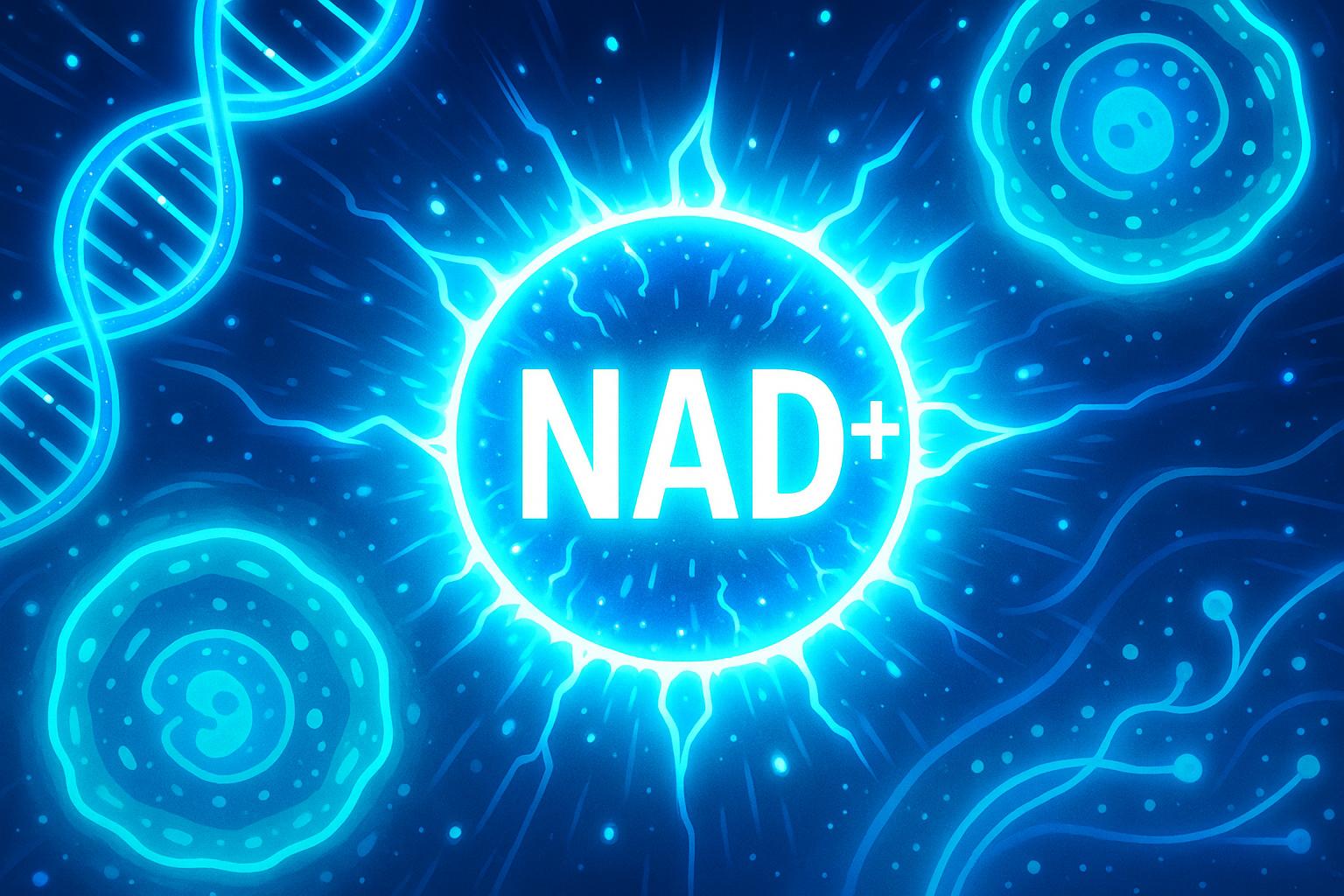Scientific breakthroughs around nicotinamide adenine dinucleotide (NAD+) are transforming aging from an inevitable decline into a modifiable biological process, with emerging therapies aiming to restore cellular energy, enhance repair, and delay age-related diseases.
Groundbreaking advancements in longevity science are redefining the way we understand aging, transitioning from the perception of an inevitable decline into a more nuanced view of a manageable biological process. Central to this shift is the molecule nicotinamide adenine dinucleotide (NAD+), which has emerged as a critical player in cellular health and longevity. As its levels diminish with age, scientific exploration has intensified around the potential for NAD+ restoration to enhance vitality, delay aging, and extend not merely lifespan but healthspan—the period during which an individual remains healthy.
Aging has often been regarded as an unstoppable force; however, contemporary research suggests it is considerably more malleable than previously thought. Factors such as DNA damage, mitochondrial dysfunction, and notably, the depletion of NAD+ contribute significantly to the frailty and cognitive decline associated with aging. Scientists have catalogued several “hallmarks of aging,” including genomic instability and epigenetic alterations, which provide insight into how cellular processes can be influenced. Notably, studies involving animal models have reported compelling results. For instance, work by Dr. David Sinclair at Harvard has demonstrated that restoring NAD+ levels in aged mice can reactivate sirtuins—proteins linked to longevity—effectively reversing signs of age-related decline. This evidence indicates that aging might not merely be a passive degeneration but a process we could potentially modulate.
NAD+ is integral to cellular operations, primarily functioning in energy production and cellular repair. By converting food into ATP—the energy currency of the cell—it supports numerous physiological processes. Unfortunately, distinct declines in NAD+ levels—up to 50% by middle age—lead to chronic fatigue, impaired metabolism, and declining immune function. Replenishing NAD+ has been shown to enhance mitochondrial functionality, promote DNA repair, and bolster brain health, potentially mitigating risks associated with neurodegenerative conditions like Alzheimer’s disease.
While science has made strides in understanding NAD+, practical applications for boosting its levels are increasingly gaining traction. Oral supplements such as nicotinamide riboside (NR) and nicotinamide mononucleotide (NMN) have come to the market, with companies innovating to enhance their bioavailability. Newly developed methods—including liposomal and sublingual formulations—aim to maximise absorption efficiency, while intravenous (IV) therapies offer immediate results. Cutting-edge products like Pure NAD+ boast advanced stabilization technologies to address absorption challenges, reflecting a paradigm shift in wellness as growing evidence supports the efficacy of NAD+ supplementation.
Moreover, the potential future of NAD+ in longevity science is exhilarating. Researchers are exploring various innovative delivery methods, such as transdermal patches and nanoparticle systems, designed for sustained release. Gene therapies aimed at enhancing NAD+ production pathways are in development, showcasing promise for broader applications in treating age-related diseases. This rapid evolution in the realm of longevity underlines not only the scientific curiosity but also raises critical discussions about equitable access to these advancements and their regulatory implications. As society grapples with these questions, the emphasis on improving healthspan—ensuring that the later years of life remain vibrant and fulfilling—will be vital.
The landscape of aging is shifting profoundly, and NAD+ supplementation signifies more than scientific innovation; it embodies a revolutionary change in our approach to aging itself. The emerging focus on maintaining peak biological function, rather than merely stave off the effects of time, heralds a new wellness paradigm. Despite ongoing debates regarding the long-term efficacy and safety of NAD+ boosters, personal testimonies suggest notable benefits, such as improved energy and sleep patterns, even if the scientific consensus is still developing.
In conclusion, the current exploration of NAD+ offers a tantalising glimpse into the potential of managing aging through scientifically-backed strategies. While challenges related to safety and access remain, the conversation around NAD+ is paving the way for significant shifts in how we perceive and approach the aging process. As ongoing research unfolds and pushes boundaries, what once seemed an extraordinary leap toward healthier aging could soon become a commonplace reality, actively making every moment count.
Reference Map
Source: Noah Wire Services
- https://www.intelligentliving.co/how-science-is-making-aging-optional/ – Please view link – unable to able to access data
- https://www.ft.com/content/68e07256-4b8c-4e12-a96e-8ad646d6a7fb – This article discusses the promotion of nicotinamide adenine dinucleotide (NAD) as a potential anti-aging solution, claiming it can reverse cellular aging, enhance metabolism, improve brain function, and boost energy. Dr. Abhinay Settipalli uses NAD on elite athletes to increase endurance. NAD is naturally present in cells and linked to genome protection. Since 1999, research has shown that higher NAD levels can improve activity in aged mice and assist in diabetes management. NAD+ is available via expensive IV drips, supplements, and at-home injections. The NAD market has rapidly grown, valued at $535.53 million in 2022 and projected to reach $1.7 billion by 2032. However, there is debate among experts regarding its effectiveness and safety. Some argue that the molecule is too large for efficient cellular uptake and prefer NMN supplements. Critics like Professor Gareth Lavery believe that boosting NAD alone cannot counteract aging and stress the importance of a healthy lifestyle. Personal anecdotes report benefits such as improved energy and sleep, though evidence on substantial anti-aging effects remains limited.
- https://time.com/5159879/is-an-anti-aging-pill-on-the-horizon/ – Researchers are investigating nicotinamide adenine dinucleotide (NAD+), a molecule found in all living cells, for its potential to counteract aging. NAD+ levels decrease with age, but studies show that replenishing it in older mice rejuvenates their tissues and extends their lifespans. In a notable study, older mice treated with NAD+ precursors showed a reversal in aging signs to resemble much younger mice. Human studies indicate similar increases in NAD+ levels with supplements. David Sinclair from Harvard Medical School is pursuing FDA-approved NAD+ treatments, while Elysium already sells an NAD+-boosting supplement called Basis, endorsed by notable scientists but facing skepticism due to limited human research. Ongoing studies aim to confirm NAD+’s effectiveness as an anti-aging agent.
- https://time.com/7266835/aging-longevity-health-span-science/ – Scientists are exploring innovative therapies to address aging, notably through a trial for treating nonarteritic anterior ischemic optic neuropathy (NAION), a condition causing sudden blindness. The trial employs a gene therapy developed from David Sinclair’s research at Harvard, aimed at reversing age-related cellular damage by reprogramming cells to a younger state. This therapy could have broader applications for conditions like glaucoma and dementia. The field of longevity science is rapidly expanding, with strategies such as gene therapy, metabolic interventions, and senolytics being investigated to extend healthspan—the period of life spent in good health—rather than lifespan alone. Researchers emphasize improving life quality and reducing age-related diseases, which could yield massive economic benefits. While Sinclair’s work, including claims of reversing aging in mice, is groundbreaking, it faces skepticism regarding its scientific rigor and commercial implications. Meanwhile, studies are ongoing to test NAD-boosting supplements like NMN and NR to enhance resilience against metabolic stress. Though results are still preliminary, the field holds promise for significantly delaying aging-related decline and improving public health outcomes.
- https://time.com/4711023/how-to-keep-your-dna-from-aging/ – Research led by Dr. David Sinclair from Harvard Medical School has demonstrated that boosting levels of the compound NAD+ can reverse signs of aging in mice by enhancing DNA repair functions. NAD+, or nicotinamide adenine dinucleotide, declines with age and is linked to the activation of PARP1, a DNA repair enzyme. In older mice, increasing NAD+ resulted in improved muscle function and DNA repair, making them biologically similar to younger mice. Sinclair’s team plans to test a human-grade version of a NAD+ precursor called nicotinamide mononucleotide (NMN) in 25 people to ensure its safety. Potential applications of NAD+ include protecting DNA from radiation damage and enhancing cancer treatment efficacy. Future collaborations include potential experiments with NASA to protect astronauts from cosmic radiation.
- https://www.lifespan.io/topic/nad-nicotinamide-adenine-dinucleotide-benefits-side-effects/ – NAD+ is a coenzyme utilized by many proteins in the human body, particularly the sirtuins, which repair DNA damage and are associated with healthy longevity in multiple species. In this way, NAD+ helps to combat genomic instability, one of the proposed reasons we age. Most cells contain the necessary repair systems to fix DNA damage. However, repairing this damage consumes NAD+, and if DNA damage becomes excessive, it can deplete the pool of NAD+ available and impact the other functions that require it. An important protein involved in DNA repair is Poly (ADP-ribose) polymerase (PARP), which relies on the presence of NAD+ to work. The level of available NAD+ declines as we age, and DNA damage increases, which, in turn, elevates PARP, which then consumes even more NAD+ to repair it. Effectively, as we age, we are caught in a downward spiral of increasing NAD+ consumption from an ever-shrinking pool of available NAD+. Experiments conducted in mice have demonstrated that treatment with the NAD precursor NMN can mitigate and resist age-related DNA damage as well as the damage resulting from exposure to radiation. Of course, this data is taken from animal studies and is subject to the usual caveat that results may not be the same in humans; ongoing research has yet to determine if these results will translate.
- https://www.vailhealth.org/news/exploring-the-role-of-nad-in-aging-and-longevity – Research suggests that the decline in NAD+ levels contributes to the aging process by impairing mitochondrial function and compromising cellular repair mechanisms. By maintaining optimal NAD+ levels, it may be possible to mitigate these effects, promoting cellular resilience and potentially slowing down the aging process. The relationship between NAD+ and longevity is a subject of intense scientific inquiry. Studies in various organisms, including yeast, worms, and mice, have shown that boosting NAD+ levels can extend lifespan. While the direct translation of these findings to human longevity is still a subject of ongoing research, the potential implications are promising. Boosting NAD+ levels can be achieved through lifestyle changes such as intermittent fasting and exercise, as well as through nutrition by consuming foods rich in NAD+ precursors like tryptophan, niacin, and nicotinamide riboside (NR). Supplements like NR and nicotinamide mononucleotide (NMN) are also available and have been shown to effectively raise NAD+ levels. As research continues, NAD+ emerges as a promising player in the quest for longevity, with potential applications in promoting healthier aging and extending lifespan.
Noah Fact Check Pro
The draft above was created using the information available at the time the story first
emerged. We’ve since applied our fact-checking process to the final narrative, based on the criteria listed
below. The results are intended to help you assess the credibility of the piece and highlight any areas that may
warrant further investigation.
Freshness check
Score:
8
Notes:
The narrative discusses ongoing and recent scientific research on NAD+ and aging, referencing contemporary work such as Dr. David Sinclair’s studies, which remain highly relevant. No evidence suggests outdated or recycled content, and there are no indications of referencing obsolete roles or deceased persons. The content aligns with recent trends in longevity research. However, no explicit publication or event date is provided within the text itself, and innovation details suggest a current timeframe.
Quotes check
Score:
7
Notes:
The narrative attributes findings to Dr. David Sinclair’s work on NAD+ and longevity; however, no direct verbatim quotes are included. The mention of his research is consistent with publicly available studies dating back several years, but no earliest or original source quote was identified. Since no direct quotations are present, a moderate score is given reflecting original summarisation rather than repeated quotes.
Source reliability
Score:
5
Notes:
The narrative originates from Intelligent Living, a wellness and lifestyle-focused digital publication. This outlet is not a major established scientific journal or widely recognised news organisation (like BBC, Reuters, or Financial Times) known for rigorous editorial standards. Therefore, while the scientific concepts discussed are generally supported by academic research, the publication’s reliability is moderate due to less stringent editorial oversight and potential commercial interests.
Plausability check
Score:
9
Notes:
The claims about NAD+ role in cellular health and emerging supplementation methods are plausible and align with current scientific exploration in longevity science. While some advanced therapies (e.g., gene therapies, novel delivery systems) remain experimental, the narrative fairly presents ongoing research and acknowledges debates on efficacy and safety. This enhances plausibility without overstating certainty.
Overall assessment
Verdict (FAIL, OPEN, PASS): OPEN
Confidence (LOW, MEDIUM, HIGH): MEDIUM
Summary:
The narrative provides a credible overview of current scientific understanding and research on NAD+ and aging, reflecting genuine advances without presenting outdated information. However, due to the secondary nature of the source—a lifestyle-focused platform rather than a primary scientific or top-tier journalistic outlet—and the absence of direct quotations verified from original research papers, the confidence is medium. The content is plausible and timely, but readers should corroborate with primary scientific literature or authoritative institutions for high-stakes decisions.













